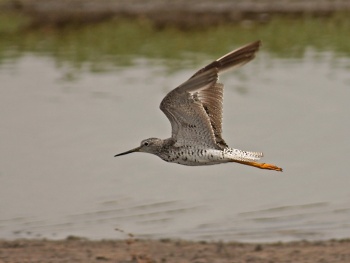(→Taxonomy: Update link) |
(Picture of non-breeder. All sections now started References updated. Incomplete gone) |
||
| Line 1: | Line 1: | ||
| − | |||
[[Image:Greater_Yellowlegs.jpg|thumb|550px|right|Photo by {{user|cspratt|cspratt}}<br />Victoria, [[British Columbia]], July 2004]] | [[Image:Greater_Yellowlegs.jpg|thumb|550px|right|Photo by {{user|cspratt|cspratt}}<br />Victoria, [[British Columbia]], July 2004]] | ||
;[[:Category:Tringa|Tringa]] melanoleuca | ;[[:Category:Tringa|Tringa]] melanoleuca | ||
==Identification== | ==Identification== | ||
| − | Easily confused with [[Lesser Yellowlegs]], but much larger (11 1/2 to 13 1/4 inches in length). Bill is longer, about 1.5x the size of the head from front to back, where head and bill are about equal in Lesser Yellowlegs. Bill is also stronger and often slightly upturned. Legs are proportionately stronger, especially the "heel" (where you would expect the knee to be). | + | 29–33 cm |
| + | *Dark brown streaks on head and neck | ||
| + | ====Similar Species==== | ||
| + | Easily confused with [[Lesser Yellowlegs]], but much larger (11 1/2 to 13 1/4 inches in length). Bill is longer, about 1.5x the size of the head from front to back, where head and bill are about equal in Lesser Yellowlegs.<br /> | ||
| + | Bill is also stronger and often slightly upturned.<br /> | ||
| + | Legs are proportionately stronger, especially the "heel" (where you would expect the knee to be). | ||
| + | [[Image:YellowLegs7-26-08.jpg|thumb|350px|right|Photo by {{user|onlybill|onlybill}}<br />[[Brazoria National Wildlife Refuge]], July 2008 ]] | ||
==Distribution== | ==Distribution== | ||
| − | + | '''Breeds''' [[Alaska]] and [[Canada]]<br /> | |
| − | '''Breeds''' [[Alaska]] and [[Canada]] | + | '''Winters''' to southern [[South America]] |
==Taxonomy== | ==Taxonomy== | ||
This is a [[Dictionary_M-O#M|monotypic]] species<sup>[[#References|[1]]]</sup>. | This is a [[Dictionary_M-O#M|monotypic]] species<sup>[[#References|[1]]]</sup>. | ||
==Habitat== | ==Habitat== | ||
| − | + | Tidal marshes, salt pans, muddy estuaries, freshwater lakes and streams. | |
==Behaviour== | ==Behaviour== | ||
| + | ====Diet==== | ||
| + | [[Image:IMG 92901.JPG|thumb|350px|right|Non-breeding<br />Photo by {{user|tetoneon|tetoneon}}<br />Naples, [[Florida]], March 2013]] | ||
| + | Aquatic and land insects, small crustaceans, fish and worms. | ||
| + | ====Breeding==== | ||
| + | They lay 4 eggs in a ground nest. | ||
==References== | ==References== | ||
| − | #{{Ref- | + | #{{Ref-Clements6thAug14}}#Handbook of the Birds of the World Alive (retrieved October 2014) |
| + | #BF Member observations | ||
{{ref}} | {{ref}} | ||
==External Links== | ==External Links== | ||
Revision as of 23:36, 1 October 2014
- Tringa melanoleuca
Identification
29–33 cm
- Dark brown streaks on head and neck
Similar Species
Easily confused with Lesser Yellowlegs, but much larger (11 1/2 to 13 1/4 inches in length). Bill is longer, about 1.5x the size of the head from front to back, where head and bill are about equal in Lesser Yellowlegs.
Bill is also stronger and often slightly upturned.
Legs are proportionately stronger, especially the "heel" (where you would expect the knee to be).
Distribution
Breeds Alaska and Canada
Winters to southern South America
Taxonomy
This is a monotypic species[1].
Habitat
Tidal marshes, salt pans, muddy estuaries, freshwater lakes and streams.
Behaviour
Diet
Aquatic and land insects, small crustaceans, fish and worms.
Breeding
They lay 4 eggs in a ground nest.
References
- Clements, J. F., T. S. Schulenberg, M. J. Iliff, D. Roberson, T. A. Fredericks, B. L. Sullivan, and C. L. Wood. 2014. The eBird/Clements checklist of birds of the world: Version 6.9., with updates to August 2014. Downloaded from http://www.birds.cornell.edu/clementschecklist/download/
- Handbook of the Birds of the World Alive (retrieved October 2014)
- BF Member observations
Recommended Citation
- BirdForum Opus contributors. (2024) Greater Yellowlegs. In: BirdForum, the forum for wild birds and birding. Retrieved 7 May 2024 from https://www.birdforum.net/opus/Greater_Yellowlegs
External Links






